Rebecca Ferguson The Snowman
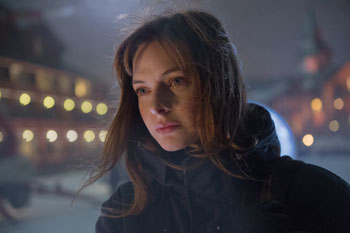
A Terrifying Thriller
Cast: Rebecca Ferguson, J.K. Simmons, Michael Fassbender, Chloe Sevigny, Val Kilmer
Director: Tomas Alfredson
Genre: Crime, Drama
Rated: MA
Running Time: 119 minutes
Synopsis: Michael Fassbender (X-Men series) leads an all-star cast that includes Rebecca Ferguson (Mission: Impossible"Rogue Nation), Charlotte Gainsbourg (Independence Day: Resurgence), Chloë Sevigny (American Horror Story), Val Kilmer (Heat) and Academy Award® winner J.K. Simmons (Whiplash) star in The Snowman, a terrifying thriller from director Tomas Alfredson (Let the Right One In, Tinker Tailor Soldier Spy), based on Jo Nesbø's global bestseller.
The frigid landscape as his hunting ground, a sociopath who calls himself 'The Snowman Killer" has targeted the one person for whom he wants to show off his methodical, unthinkable skills: the lead investigator of an elite crime squad. With cunningly simplistic baits such as 'Mr. Policeman, I gave you all the clues…" he begs to have a worthy opponent to play his sick game.
For Detective Harry Hole (Fassbender), the murder of a young woman on the first snow of the winter feels like anything but a routine homicide case in his district. From the start of the investigation, The Snowman has personally targeted him with taunts"ones that continue to accompany each new vicious murder.
Fearing an elusive serial killer long-thought dead may be active again, the detective enlists brilliant recruit Katrine Bratt (Ferguson), to help him connect decades-old cold cases to the brutal new ones. Succeed, and they will lure out the psychopath that's been watching them from the shadows for who knows how long. Fail, and an unthinkable evil will strike once again during the very next snowfall.
The Snowman
Release Date: October 19th, 2017
www.thesnowmanmovie.com
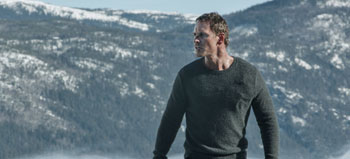 About The Production
About The Production
The First Snow: The Snowman Begins
'The Snowman," the seventh book in Jo Nesbø's best-selling Harry Hole series, has enthralled global audiences since it was first published in 2007. The novel took the beleaguered detective and his creator to an entirely new level and readership, and it topped The New York Times Best-Seller list in U.S."as well as marked Nesbø's first No.1 in the U.K. charts and firmly establishing his place as one of the elite international crime writers. Of course, Norwegians had known this for some time…it just took the rest of the world a few years to catch up.
'In some countries it was a breakthrough novel for me," explains Nesbø, who has sold a staggering 34 million-plus books worldwide. 'With my third novel, -The Redbreast,' I got a following of a high-brow crime audience, but then with -The Snowman,' I had mainstream success."
For the majority of U.K. and U.S. readers, this was their first introduction to the cop, and they believed Nesbø to be an overnight success. 'The truth is that I had been in those countries and published for around 10 years," he laughs. 'It was a bit like when Tom Waits had success with -Swordfish Trombone,' a journalist asked him, -What did you do to finally find success?' He said, -I didn't do anything differently. I've been here for 15 years. It's not me coming to you, it's you coming to me.'"
Indeed, the world of Det. Hole is wholly iconic in Scandinavia, and his creator cultural royalty. Today, fans from across the globe visit Norway to re-create the fictional path Hole has trodden on the icy streets of Oslo, paying homage to his favorite haunts"such as the iconic Schroder's Café"as they try to get inside the mind of this most elusive of investigators.
Hole is to Oslo what Sherlock Holmes is to London, and likewise has spawned a mini industry; one can even book a Harry Hole tour. 'Harry's become an institution in this world," observes producer Robyn Slovo. 'He is undeniably an iconic character who is a laconic, difficult and introverted non-team player, but an intrepid and gifted policeman. Still, he is reluctant to be pulled into this particular investigation instigated by somebody else,"
With 'The Snowman's" book-to-screen adaptation comes the exciting proposition that Europe could have its own cinematic detective series. In fact, not since Holmes has the continent owned this genre. In comparison to the States, detectives hunting serial killers is not a well-trodden narrative for European cinema; TV perhaps, but not the big screen.
What is it about the investigator that enthrals readers all across the world? Like so many of his literary associates, he is a wholly flawed man who struggles with a personal life littered with ragged cracks and dark crevices. An alcoholic who is unreliable and disorganized, he has an innate inability to commit. Still, for all his personal failings, he is the consummate detective: scrupulous, determined and creative"a man who will stop at nothing until justice has been served. He is the genuine antihero, an impossible character, but impossible not to like.
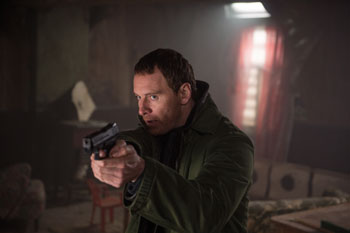 'This is a man of many contradictions," reveals Nesbø. 'He believes in the legal system, he believes in the Scandinavian democratic model; yet, he's an outsider who doesn't feel at home in Scandinavian society. He cares for those who are close to him, but he doesn't want anyone to be close to him. He's struggling between being a man who loves women"and one woman in particular"but who is trying to find a way to live his life alone. He doesn't want to be a member of the herd, and yet he has this deep social reflex that many of us have; we feel this urge to contribute to this herd."
'This is a man of many contradictions," reveals Nesbø. 'He believes in the legal system, he believes in the Scandinavian democratic model; yet, he's an outsider who doesn't feel at home in Scandinavian society. He cares for those who are close to him, but he doesn't want anyone to be close to him. He's struggling between being a man who loves women"and one woman in particular"but who is trying to find a way to live his life alone. He doesn't want to be a member of the herd, and yet he has this deep social reflex that many of us have; we feel this urge to contribute to this herd." Harry Hole is brilliant-yet-flawed, rebellious-yet-loyal and anti-establishment, yet highly regarded by his fictional associates and real-world fans. In turn, this created significant obstacles for anyone embarking on a big-screen adaptation.
'The challenge in adapting Harry to screen, aside from preserving those characteristics that make him so unique, was to avoid falling into a clichéd representation of a flawed policeman solving a crime," explains Slovo. 'We've tried to make Harry unpredictable, original in his thinking, not terribly socialized, not exactly charismatic. He's definitely what might be described as difficult, and that is what's been challenging in bringing him to life. He's not 100-percent action hero. He's a thinking man's detective who is put in very dangerous and difficult situations."
A story about a serial killer is not what would be considered usual fare for four producers whose accomplished work runs the gamut from Catch a Fire and Les Misérables to Tinker Tailor Soldier Spy and Love Actually, but their allure to the material lay very much in the proposition of director Tomas Alfredson.
Alfredson discusses that his approach to filmmaking is to guide the audience through his work, but never decide what each individual should experience. He explains: 'My films are each a piece of entertainment, but they cannot just be that. I need them to be something else, too"to tell something about people or society, or a part of the world you haven't seen before. My goal is for people to react physically"to get scared, laugh or to sweat. The more different the reactions, the better. It's lovely to meet with people from an audience and hear very different things. That's when you've succeeded."
This commitment to his craft leads the filmmaker to be quite selective in the stories he chooses to tell. Alfredson admits he found Nesbø's protagonist to be riveting. 'When I read a story, I try to find an animal for each character. Is he or she a rabbit, wolf, dog or a cat? Not visually, but the soul of a certain animal. To me, Harry is an owl; he is someone people don't see, but who sees everyone else. He's very smart and silent; he knows when to speak and when to interact. But he also feels alienated with the rest of the world. His private life has fallen into pieces, and the only thing that works is his intuitive talent as an investigator."
Slovo commends: 'Tomas offers a particular interpretation on things, which means we could take a best-selling genre thriller and turn it into something unexpected. Because it's set in Scandinavia and Tomas is Scandinavian, the excitement was involved in his original take, not going the Scandi-Noir route. We'd rather a route with a director who has proven himself to be good at noir, tension and at surprise. He has also proven to himself to be particularly good at horror. All those elements made it feel like a good fit."
'The Snowman does have that other element that previous books don't have, and that is the horror element," adds Nesbø. 'The title -The Snowman' conveys a certain image, as does the idea of an innocent thing that is taken out of context and put in a new context; the more cozy and familiar it is, the scarier it becomes."
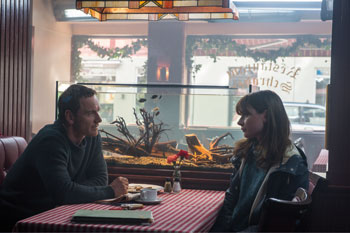 Discussing handing over the reins of a cherished property to another creative team, the author reflects: 'They chose a director who is a storyteller in his own right and who isn't there just to give a version of the book, but who wanted to use the book as input for his story. As a storyteller myself, I wouldn't have it any other way. Tomas' understanding and my trusting him made it easy for me to say -Take these pages that are written and use them as a helpful input for a story that you want to tell."
Discussing handing over the reins of a cherished property to another creative team, the author reflects: 'They chose a director who is a storyteller in his own right and who isn't there just to give a version of the book, but who wanted to use the book as input for his story. As a storyteller myself, I wouldn't have it any other way. Tomas' understanding and my trusting him made it easy for me to say -Take these pages that are written and use them as a helpful input for a story that you want to tell." Alongside Slovo and Working Title's Bevan and Fellner, The Snowman team was joined by producer Piodor Gustafsson, who has worked with Alfredson for the past six years. What Gustafsson so appreciated about the character of Harry was his deep sensitivity. The producer explains: 'Being very vulnerable makes Harry much more interesting than a hard-boiled detective. As empathetic people, we see ourselves in him. After solving a case, he's been so infected by it that he can't protect himself from the evil he's had to approach. He's such a reluctant detective and doesn't want to continue the work. But he's the best, and until someone who's better than him comes along, he must continue."
Casting the Antihero: Fassbender Comes Aboard
Selecting the protagonist for The Snowman was always going to be complex process. When news first got out that Det. Harry Hole would be adapted for screen, the rumor machine went into overdrive"with speculation rife as to who was going to manifest this literary sensation. Everyone, it seemed, had a strong opinion. 'There were many people we had to take into consideration," explains Slovo. 'Absolutely you have to please readers and the prospective cinema audience."
It would be disingenuous to say the investigator was written for Fassbender from the outset, but consider Nesbø's description of Harry in which he describes a tall, athletic, lean man, 'blonde hair, machine-cropped", and you're not a million miles away from the German-born performer.
'When I heard that Michael was going to be Harry, I thought it was a brilliant choice," says Nesbø. 'Shame was one of the great movies of that year and Michael was the best actor I saw that year, so I was thrilled. The perfect Harry doesn't exist, but an actor with Michael's ability is as close to the perfect Harry as I can imagine."
'We had great material to work with"the source material from Jo and a finely worked script. That, combined with a great director, was helpful in attracting great actors," gives Slovo. 'When Michael's name first came up as a potential, there were no arguments or debates as to whether he could play Harry. He seemed like a perfect fit…provided of course he wanted to do it."
Alfredson notes that he appreciated the lack of vanity in Fassbender's approach. 'He's very aware of the camera," reflects the director. 'Not just from his point of view, but what the camera does and how you block the scene. Michael is an open-minded and proper film actor who is naked with what he does. He trusts his intuition but is open to direction; he's perfect in this role."
For Fassbender, there was never any question about wanting to portray Harry. He had long hoped to shoot with Alfredson, but the opportunity had not arisen. The challenge was timing. Since 2009, he has been filming back to back, and The Snowman had to be squeezed into two other major productions"Assassin's Creed and Alien: Covenant"with no room for scheduling error.
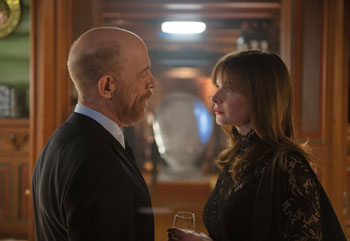 Fassbender was determined to make it work for the opportunity to work. 'The first thing that enticed me about the project was Tomas," says the performer. 'Then I read the script and thought it was interesting. I liked the character and this genre."
Fassbender was determined to make it work for the opportunity to work. 'The first thing that enticed me about the project was Tomas," says the performer. 'Then I read the script and thought it was interesting. I liked the character and this genre." The role presented Fassbender with his first detective. 'At the time of the script arriving at my door I didn't know anything about him," admits Fassbender. 'It was a totally new world for me. Then I started to expose myself to the books and the world that Harry occupies, and I've become very fond of the character."
That said, ahead of playing Harry, Fassbender was wary of reading the books. 'The script is independent of the book, and I didn't want to get attached to things that were in the book but not in the script. I did, however, read the beginning, to get an idea of where this character started, what Jo's version of him was. I just wanted to see where those raw characteristic traits were"the description of him and his physicality.
'It's difficult to improve on someone's experience of reading the book when you are making the film," Fassbender continues. 'As a reader you are filling in a lot of the blanks. The descriptions of the murders can be a lot more horrific and haunting because our imaginations are much more vivid, scary and twisted than what you see in cinema."
Both leading man and director were also keen to stay away from the clichés that one could fall into with on-screen cops. 'There are a lot of pitfalls with detectives we've seen on screen in the past," says the actor. 'We've stayed away from that and come up with something iconic, but original."
Fassbender appreciated Harry's quirkiness, which comes down to the character's social ineptitude. 'He's cool but doesn't try to be cool; he's very much his own individual. Harry does what he does because he has his own compass; it doesn't bother him what other people make of him. While sensitive he's not necessarily interested in being socially accepted, even in his workplace. He's a bit of a loner and forces people to put in more hours than they might like to."
His commitment to the job aside, there are many complex layers to Harry's personality that makes for interesting interpretations, not least of which is his alcoholism. 'He has an addictive personality, and where that comes from is hard to say," says Fassbender. 'Was he born with it, or did come from his occupation? There's the argument that people resent the thing they're most good at. He is a sensitive character who drinks to close himself off to the sensitivity of the things he's seen. There's a lot there that's interesting and complex to play with."
We know from previous novels that, when drunk driving, Harry was responsible for the death of another police office in a car accident. 'The department did a cover-up job and pretended that the other officer was behind the wheel, and that Harry was just a passenger. He's carrying that shame around with him," Fassbender reflects. 'He didn't get the opportunity to fess up. That's foreshadow to his character; he's carrying something like that around, which feeds into that drinking and self-destruction."
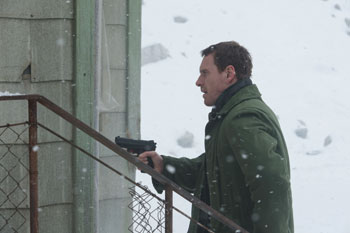 Of course once Harry gets a scent of a case that intrigues him, his focus relocates and the need for booze lessens. The period of sobriety begins, but his vulnerability is never far away, always present beneath the leather exterior. 'When he gets into physical danger with adversaries, he comes out worse for wear," says Fassbender. 'Compared to a lot of films where there's an invincibility about cops, Harry is vulnerable. He is not only scarred on the inside, but he also physically carries scars from each of the stories."
Of course once Harry gets a scent of a case that intrigues him, his focus relocates and the need for booze lessens. The period of sobriety begins, but his vulnerability is never far away, always present beneath the leather exterior. 'When he gets into physical danger with adversaries, he comes out worse for wear," says Fassbender. 'Compared to a lot of films where there's an invincibility about cops, Harry is vulnerable. He is not only scarred on the inside, but he also physically carries scars from each of the stories." Fassbender plumbing these character details won over his production team. 'Michael is absolutely fantastic in this role," raves Slovo. 'He's astonishing. He clearly likes playing the role, and he worked very, very hard for Tomas."
Women of Harry's Life: Ferguson & Gainsbourg Join
The central relationships in The Snowman are between Harry, who is still in love with Rakel Fauke, played by frequent Lars von Trier contributor Charlotte Gainsbourg, as well as his developing partnership with young cop Katrine Bratt, portrayed by Mission: Impossible series' Rebecca Ferguson.
Harry is on the rebound, having split up with girlfriend Rakel but still holding a flame for her, and he meets a vibrant, gorgeous rookie at work. 'What's interesting to us is that the relationship becomes not as one might predict," explains Slovo. 'One might expect the triangle to go a certain way, but it doesn't, and that's an unexpected relationship within the film. Rather, the story is precisely about the complexities and intricacies of this relationship and the two very different investigative styles."
Like their male protagonist, both Rakel and Katrine are complex characters with a past that binds them to Harry, which in Katrine's case reveals itself as the story progresses. The film holds a number of secrets, and those secrets are carried predominantly by the relationship between Harry and Katrine.
The audiences is first introduced to Harry just after he returns from solving another case…and fresh off another bender. 'In the beginning, Harry comes back from a period when he's been away at his cabin, treating his vulnerable soul from an old case," says Gustafsson. 'When he comes back to Oslo, and to the police force, Katrine has just joined. She has a hidden agenda to lure him into, and he's attracted to her energy and enthusiasm."
'Harry becomes fascinated by Katrine because she is so passionate about her work," Alfredson continues. 'She is concentrated on cases she's been studying"ones in which women have disappeared simultaneous to the snow falling. Of course, it seems to be an odd coincidence and an odder theory. But Harry becomes interested in what she has to say and drawn into her theory. They uncover more about this serial killer who leaves a business card in the form of a snowman"one that is turned toward the victim's house."
The older cop and rookie are not only bound together by the plot, they also share certain traits, as Ferguson explains. 'Harry recognizes himself in her," offers Slovo. 'When they meet for the first time there's a definite connection between them, born out by the fact they are very similar. They both struggle to interact with other people. I wouldn't say she's specifically outcast, but she definitely sticks to herself and has hidden agendas as a motivation. She has a drive, a real will to work as a policewoman, and she believes in what she's working toward."
'Harry's inspired by her," agrees Fassbender. 'She's a passionate police officer and he feels like there's a lack of that in the police, where people are increasingly complacent."
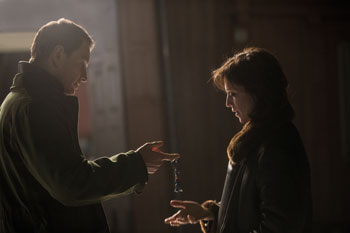 heir first meeting takes place in the police station's smoking room; it is Katrine's first day at Oslo's busy police headquarters. Katrine stares at him in surprise, recognizing him, but finding it hard to believe it's the legendary Harry Hole. Her disappointment is evident, and it seems the tone is set, but as the story progresses it becomes clear that their connection runs a lot deeper.
heir first meeting takes place in the police station's smoking room; it is Katrine's first day at Oslo's busy police headquarters. Katrine stares at him in surprise, recognizing him, but finding it hard to believe it's the legendary Harry Hole. Her disappointment is evident, and it seems the tone is set, but as the story progresses it becomes clear that their connection runs a lot deeper. 'What's interesting about the relationship is that it's quite unexpected," explains Ferguson. 'If you imagine this idea of a man who is supposedly the best detective in Europe"and in comes this semi-drunk"it's a confusion of emotions for her when she meets him. She's studied his cases. He's the one she's putting her faith into, and she's balancing this with her own agenda. It's a beautiful connection between them. It is man/woman, father/daughter. It balances all kinds of relations."
When casting the performer, did her Scandinavian origins have any bearing? In Ferguson, Alfredson found a kindred spirit in his fellow Swede. He notes: 'There's a secret frequency that we share coming from the same region. She understands what silences are, and how long silences should be. It's been wonderful to work with her, and I appreciate how incredibly protective she is of Katrine. She brings 20 personalities to her expressions and is simply fantastic."
Like Fassbender, Ferguson was eager to join an Alfredson production and made it quite clear how eager she was to play Katrine when they first met in Sweden. Ferguson wanted the job the moment she got the call from her agent. It didn't take much to convince Alfredson.
'It's funny when your agent calls and tells you -Tomas Alfredson is making a movie based on a Jo Nesbø book…and they're looking for the female character opposite Michael Fassbender," shares Ferguson. 'It's like finding Willy Wonka's golden ticket. I love Jo, I admire Michael greatly and I've always wanted to work with Tomas. He's one of the top five directors for me. I remember I had a meeting that day, which I cancelled immediately, and booked a ticket to Stockholm to meet Tomas.
'Sometimes we call people a -visual director' or a -character director,' continues Ferguson. We love putting people in small boxes, but I can't put Tomas in any box. His attention to detail is impeccable, not just with the choices his characters make, but with the scenery. For example, the angle of a broken twig is something that you wouldn't even think about, but for Tomas there's a golden measurement for that particular angle. He will sit down and talk about the length of my fringe. He wants it just long enough to be a bit annoying so people just want to brush it out of your face, but it can't cover the eyes. He's extraordinary!"
What did Ferguson see in Fassbender's interpretation? 'I can't even see how anyone else can play Harry now," she reflects. 'Michael finds the subtlety and makes him into this incredible detective with enormous vulnerability. He balances emotions that are real. There are so many layers to Michael's acting, and we can interpret it however we wish. He is absolutely phenomenal."
A theme that runs throughout the book series is Harry's complex relationship with Rakel. He needs her and yet, at the point at which we are introduced to Harry in The Snowman, she has left him"unable to cope with the darkness that haunts him. 'Yet he really wants to be with Rakel as a soul-mate and as an equal," offers Fassbender.
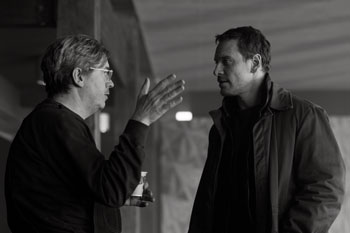 For Rakel, they needed someone who would not only measure Harry in age, but could convincingly be that woman whose presence in Harry's life would continue to haunt him. 'It's challenging thing in the film industry and, in the way that we make stories today, it's quite a hard ask to find an older woman who can pull off being the woman Harry's never stopped loving," explains Slovo.
For Rakel, they needed someone who would not only measure Harry in age, but could convincingly be that woman whose presence in Harry's life would continue to haunt him. 'It's challenging thing in the film industry and, in the way that we make stories today, it's quite a hard ask to find an older woman who can pull off being the woman Harry's never stopped loving," explains Slovo. 'Charlotte Gainsbourg is such an ideal actor for that particular role. She's totally gorgeous and charismatic. Why would you ever stop being in love with her?!"
The daughter of the English actress/singer Jane Birkin and French musician Serge Gainsbourg, the performer was born in London and raised in Paris, and it is these European roots that made her so right for Harry's world.
'Charlotte's very European and inhabits the role so easily," reflects Slovo. 'She brings a gravitas, classiness and elegance to the project. She's a graceful actress and the triangle of her, Rebecca and Michael's characters' relationship works tremendously well. There's a lot of complexity between all three of them, and none of them are playing stock roles."
To date, Gainsbourg has made approximately 35 films"ranging from the high costume drama of Franco Zeffirelli's Jane Eyre to the more recent and controversial Nymphomaniac with Von Trier. She is one of cinema's most enigmatic provocateurs. Many of the women she has portrayed on screen have encountered violence before, be it either as victim or perpetrator.
Rakel is at once an incredibly strong and powerful figure, and yet she is clearly one of those women who is most taken in by the danger of the story. She is like the moral center of the story. 'She's not in the thriller, she's in a not ordinary dilemma," Gainsbourg says thoughtfully. 'She's between two men; she has this wonderful relationship with Harry, something that lingers on and that's what I like playing. That's what I was interested in. The thriller aspect feels like it's on my shoulder, but I never really touch it, until the end."
Cops and Suspects: Supporting Cast
It's a measure of how well regarded and respected Alfredson is by the acting community that The Snowman features some of the finest acting talent, giving up their time to play small roles, by comparison to their usual gigs.
'Something that is very special about this film, and it's the special thing about Tomas, is that we have actors of enormous qualities for actually quite small roles," shares Slovo. 'Chloe Sevigny, J.K. Simmons, David Dencik, Sofia Helin, and Toby Jones"who was with us for only three days, but brought such extraordinary humor and presence to his character. These are not cameo cast.
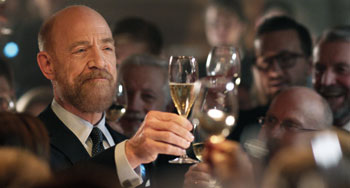 These are actors who are properly inhabiting the role that they've been chosen for. They have all done it because they want to work with Tomas, because of the script and the existing material. They're here for their performances, and they are fantastic across the board."
These are actors who are properly inhabiting the role that they've been chosen for. They have all done it because they want to work with Tomas, because of the script and the existing material. They're here for their performances, and they are fantastic across the board." One such actor to receive the call was Toby Jones, who had worked with Alfredson previously on Tinker Tailor Soldier Spy. 'Tomas wrote me a very charming letter in which he asked if I would play this small part. He saw it as a favor, but to be honest, I would do anything to work with Tomas," says Jones. 'It's rare when you feel you're actually learning about acting from a director. It's an interesting sensibility that he has. To spend any time with him you would be foolish not to take him up on it."
Jones knew that however small the part, Alfredson would explore the curious corners the story had to offer. 'Even though I'm in a small corner of that story with Val, the corner would be given equal significance in the way Tomas handled it. There is no corner of the film that he feels as less worthy of scrutiny than any other, and I this is what surprises many of the crew. Each scene offers a potential other way of looking at the whole story. That's what makes Tomas an exceptional director.
'He has a complete understanding of structuring how a scene should be shot, but also he seems to provide you with enough information that you feel free"even though he's being specific about what he requires. That's because he understands all the nuances of a story," continues Jones. 'This is very unusual in a director. Maybe it's to do with his theater background, but he's able to open up a scene and shoot it from an unexpected angle"in order to investigate weird nuances of behavior between the characters. He provides unusual spatial relationships that open up different emotions than you're normally used to in a film."
When it comes to dedication and determination to work with Alfredson, there is one actor who sacrificed more than most to work for a handful of days during one of the most weather challenged periods of the shoot. Step forward one of cinemas most iconic screen heroes Val Kilmer.
In The Snowman, there are a series of murders investigated by a detective, but in fact this film takes place in three different time scales. In one of the time threads, it focuses on a detective called Gert Rafto who, while not related to Harry Hole, was investigating a serial killer a decade earlier who had the hallmarks of today's Snowman. This larger-than-life character is a man who, sums Alfredson, 'is what would happen to Harry if he got in too much more drinking."
'We chose Val Kilmer, and he brings such pathos and a charisma and a beauty to the role," raves Slovo. 'As with our other supporting cast, it's a small role, but it's a very important strand in the story. Val was with us for just a few days, but he left a real imprint and gives a wonderful performance. He is the jewel in the midst of our film. He is just such an iconic actor, and such a beautiful man."
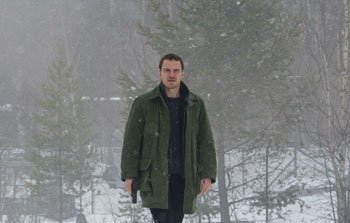 At the time of production, Kilmer was recuperating from a severe illness, but was determined to work with Alfredson. By comparison to what any of the other actors had to endure, his was the most physically demanding"at one point, his character had to stand on top of a mountain overlooking Bergen. The day that scene was shot, the weather was so awful that only essential crew were permitted to be on site. The snow and wind was unrelenting, but it met its match with Kilmer. Undeterred, he stood at the precipice where no other feared to stand"wind whipping, snow blinding, to get the shot.
At the time of production, Kilmer was recuperating from a severe illness, but was determined to work with Alfredson. By comparison to what any of the other actors had to endure, his was the most physically demanding"at one point, his character had to stand on top of a mountain overlooking Bergen. The day that scene was shot, the weather was so awful that only essential crew were permitted to be on site. The snow and wind was unrelenting, but it met its match with Kilmer. Undeterred, he stood at the precipice where no other feared to stand"wind whipping, snow blinding, to get the shot. Another actor of impeccable pedigree is Academy Award® winner J.K Simmons, again playing quite a small, but critically significant role. 'His character permeates the entire story," says Slovo. 'He's a politician, a business man, a mover and a shaker who colors all sorts of areas of the story. J.K just brought something so extra to the role. He was absolutely fantastic, and he's got the most beautiful voice. He plays a very potent character, a powerful man of Oslo, and it's that gorgeous voice"with this dignity and bearing"that adds to his incredibly good acting."
'Serial killer genre is not something I'm particularly drawn to," admits Simmons. 'But this movie elevates the genre. The crimes are complex and intricate"as well as shockingly intelligent, awful and gruesome"but what I find so interesting about the story are the characters and how they relate to each other."
Designing Norway: Building The Snowman's World
BAFTA and Academy Award®-nominated production designer Maria Djurkovic first worked with Alfredson on Tinker Tailor Soldier Spy, and found a kindred spirit, visually receptive and open to the extraordinary and cinematically unconventional ideas.
'Tomas is the most visually literate director I can think of, and working with him is such a joy. He sets such high standards, and he's one director I would fight people to work for," Djurkovic raves. 'He allows one to push and heighten things far more than one would normally be able to do. He encourages the bold flourishes."
Flourish is something of which The Snowman is in no shortage. A strong and uncompromising visual look forms a backdrop to the darkness and tension of this serial killer thriller, in a genre that is not usual territory for a designer celebrated for her period work (note her lauds for The Imitation Game). 'I knew that doing a contemporary film with Tomas would have the same design opportunities. His ideas are so bold and so different to anybody else's."
Naturally, crafting the look of a production set in Norway enables a designer to have complete control of the environment. Every detail has to be considered, from the banal to the breathtaking"from road signs, cars, dress and architecture. 'With Tomas, every single tiny thing is thought about and discussed and considered," she shares. 'Visually there's far more opportunity to manipulate."
Creating the scene for The Snowman began in 2014, when Alfredson and Djurkovic set out to Norway to explore the city in search of the film's visual palette. 'It was always important to Tomas to shoot The Snowman in Oslo," she reveals. 'This is a city with many different sides. We wandered around Oslo and Bergen looking at everything. Tomas discussed the vision he had, and I was trying to lock into his thinking. We looked at art galleries, museums, architecture, just building up a visual palette."
It was only when they visited the celebrated City Hall in Oslo that the pieces started to come together for Djurkovic. 'We came to City Hall where we saw these fantastic carvings on the exterior of the building and I had this eureka moment. I suddenly understood what he wanted from this film."
The carvings in discussion are a series of 16 wooden friezes depicting foundations myths of Norway. Created by the Norwegian painter and sculptor Dagfin Werenskiold (1892-1977), they are bold, colourful images portraying the lives of gods and the stories of wisdom and love, war and hate, and visions of the future that are woven into the fabric of Norwegian culture. These imposing carvings line the walkway leading up to the entrance of the hall, a building whose design was based on the principals of functionalism, and so stand in direct contrast to the carvings.
Functionalism celebrates the practical, the utilitarian, where there is little practical purpose for art. Step inside the building and while the principals of functionality continue, the interior reveals vivid color and boldness. 'There was something about the architectural boldness and harsh character of the exterior building, and yet inside there are these incredible friezes," reflects the production designer. 'There is an exuberance to the building, and combined with the color palate of the murals I suddenly understood. These murals are absolutely incredible, and it's this deep saturated color, this particular palette. That set the tone and that you see throughout the film."
Enter City Hall and you get a sense of what Djurkovic discusses. Snow landscapes devoid of color"as depicted by the monochrome marble stone floors of silvers and grey"contrasting with the rich, saturated color of urban interiors and cosmopolitan life as referenced by the wall murals. 'I went away taking City Hall as a visual anchor. The Snowman is either completely monochrome or it's saturated with colour. There are no primary colours, but they are dense and tonally very rich and deep."
These grey, monotones is a theme that costume designer Julian Day intuitively felt was the right direction to take Harry's look. The early mood boards he showed Alfredson reflected this"tonal greys and soft, natural greens.
'I sent these pictures of charcoal and of a tree. The charcoal was quite interesting; it was just shades of grey, and that's essentially what Harry wears," says Day. 'Tomas was specific about trying to get a Norwegian, or Scandinavian, feel to the film. So I wanted to create that look, but from an international point of view, so I used a lot of designers that are based in Sweden"as well as some Norwegian designers, and some Danish ones. For instance, Harry's jacket is a Swedish army jacket, and the trousers he wears were produced in Sweden. Harry's look isn't specific to any time period, it could be 1940s, it could be now, and it could be in 10 years' time."
Like some of his more cerebral screen detective contemporaries, Harry is not bothered by his appearance or influenced by personal affects. He doesn't visually stand out, but rather blends with the landscape in which he operates, and that is the field hunting serial killers, not in the office.
When it came to creating the Police HQ, Alfredson specifically called for an environment that would be the polar opposite of Harry"a place where a man like Harry would instantly feel out of place, uncomfortable and resistant to. Harry's mood, his emotional state permeates the entire film. While it's down to Fassbender's performance to manifest his character's temperament, it was the design team's job to reflect this in the environment. The police HQ is a case in point.
'Our police station is the funkiest police station you'll see anywhere," says Djurkovic gleefully. 'That was important to Tomas because it's was key that Harry feel out of place there." So the team created the most nurturing, employee friendly workspace they could imagine.
'It's the complete opposite of a typical office environment," says Djurkovic. 'It's this employee friendly space where people are cared for and nurtured. Harry's the one who feels slightly ill at ease with all of this. There's table tennis, giant upholstered balls for sitting on, break-out areas. It was all done slightly tongue in cheek. Then you see Harry in the office he shares with Katrine. He's got a shelf dividing his space from her, and he's put posters up to actually seal him off from all that nonsense. It's not just about the atmosphere of that character, but what you can do with the atmosphere of a different space that makes him feel ill at ease or uncomfortable."
In contrast to the positive energy of police headquarters, Harry's personal space is stark and empty. 'Harry is a man who is not interested in surrounding himself with nice things," explains the production designer. 'He's got an incredibly cool, Bauhaus-style apartment, but it's bare and spare. Personal effects are simply not important to him."
What was important to Alfredson was the vantage point of the flat. He wanted it up high with a commanding view of Oslo. 'Tomas wanted him to be like an owl sitting his nest with the view out of Oslo out of his windows," says the designer. So the team built the interior in an office-block development which had wrap around windows looking out over the city. It was literally a building site, with workmen developing other areas of the building, huge working cranes outside, but Alfredson used this detail to his advantage. He even engaged the help of the crane operators who, on radio cue, would operate the cranes to enhance the frame he was seeking.
'We made use of the windows, the view and light changes to great advantage. With the light changes it was really worth doing," says Djurkovic. 'With Tomas, it is constant dialogue; it's like a tennis match with ideas going back and forth in a productive way. He pushes one like no other director does. You can never just be satisfied with something. He will always come back and push you that much further. That's a great thing; the visuals are so important to him."
'He's a true auteur, and there are very few auteur's left in cinema, it's all done by committee" offers Day. 'But Tomas has control over everything you see on the screen."
In Pursuit of Snow
From the condensation on chilled glasses of champagne to the establishing of snow scenes, it was crucial to Alfredson to showcase reality. 'Tomas was not interested in having fake snowmen or fake snow," says props master Chris Cull. 'Fake snow looks different, feels different and reacts differently."
To ensure authenticity a snow supervisor was brought on board. Enter Johan Harnesk, whose task it was to ensure Alfredson had real snow, and that real snow was authentic to the setting in which it was set. While the film was shot in Norway during the winter and snow was bountiful, as time progressed…spring beckoned. Some areas would need an additional lift, but it was when production moved into studio work that Harnesk really had his work cut out for him. After shooting on location for months, exposed to the harsh elements of a Norwegian winter, the crew were looking forward to two weeks in the controlled environments of a warm and dry studio. But this was not ordinary production. In fact the producers had rented a refrigerated warehouse in the dock lands; this allowed them to shoot the studio scenes and enable Alfredson to work with real snow.
'We brought in real snow and froze the studio down to minus 5 to keep the snow intact and the breath visible," the snow supervisor explains.
Huge truckloads of the white stuff was brought down from Holmenkollen that lies above Oslo, home to the famous ski slope. For a snow expert in the film industry he's seen pretty much everything, but this was the first time he's had to work in this way. 'It's quite uncommon, I've never done it before, but Tomas likes to work with real snow so we've done it a lot on this film."
Of course, as soon as you start stacking large quantities of snow onto trucks it starts to compact, so the next job, on arrival at the studio, was to aerate the snow using tractors and forks"before then taking it into the studio.
Which begs the question, is there really much difference between fake snow and real snow? 'It depends where you have it," Harnesk explains. 'On the ground fake snow is like dead snow. It has no life, it doesn't glimmer. Real snow has this life, you can see it in the light. It contains so much color, while fake snow has one color. It really makes a difference when you're close to it."
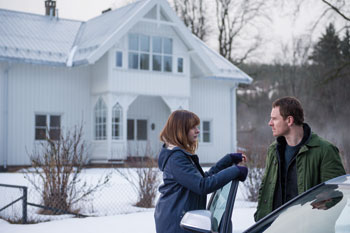 Winter Landscape: Locations of the Thriller
Winter Landscape: Locations of the ThrillerOslo is to Harry what Sherlock is to London. The two are inseparable, their identities so intertwined it was it was an absolute necessity that the film be shot at source. Alfredson was adamant from the start that the film be shot in Nowrway. He wanted to show the importance of silences, the specific rhythm of that quiet northern city, and its unique look.
The production team was dedicated to honoring the backdrop of the Harry Hole novels, and they would battle the frigid cold to bring audiences straight into the heart of the detective's world. 'The book takes place in Oslo and Bergen," notes Gustaffson. 'That was a very important element for all of us. By scouting a lot here, Tomas"at an early stage"was trying to find the DNA of Oslo that he could relate to. Locations such as Frogner Park that we were able to use underscore that relationships that Tomas developed with the city of Oslo and the city of Bergen. We were able build ones with the politicians and the municipalities, and the collaboration between the film team and both cities was enormously rewarding. The backup we had"coming down to blocking streets and securing parking spaces"was fantastic. They were very, very supportive."
It wasn't simply to honor the story that the director was so adamant about showcasing his home country to the world; it was very much a matter of pride. 'Norwegians are obsessed with the landscape that they're brought up in," Alfredson offers. 'They need the mountains and the enormous proportions that you feel when you're there. It's something that becomes a part of you, and I wanted the nature in this film to be its own character, with its own proportions. The impact of it shows you just how small one person really is. It also varies a lot within Norway, but it's never dull or uninteresting."
When asked about her experience of shooting in Norway, Gainsbourg offers: 'I was very interested in what Tomas had to say about shooting in Oslo, the importance of silences, and the rhythm, which I kept very strongly throughout the film."
The city has been used to its optimum, showcasing every aspect the city has to offer on screen. 'We show off the city," explains locations manager Camilla Stephenson. 'We are using almost every area, from the most modern, which is the Barcode area, where it's still being built, to the oldest aspects of the city, iconic buildings like City Hall."
'The Snowman is Norwegian in its setting, it's Norwegian in its character, it's set in landscapes that can only be Scandinavian," adds Slovo. Still, it wasn't a given to lens there. 'Originally when you approach a book adaptation you always have in the back of your mind that you may end of shooting it somewhere else."
Before the film settled in Norway, other locations had been considered, from the States to Sweden and even London. 'Primarily because Norway is expensive, and we thought we wouldn't get production value for the budget that we had for this film," explains Slovo.
As it happens, following lengthy negotiations, The Snowman became the first international feature shot in Norway to receive funding from the new state incentive program designed to attract foreign film and television productions. In fact The Snowman is the biggest film to date to have been shot in Norway in its entirety.
Over the course of the 12-week shoot, production took advantage of the staggering locations Norway has to offer, from the cool, urban style of Oslo to the World Heritage city of Bergen, the vast, dramatic snowscapes of Telemark region to the iconic Atlantic Road that hugs the rugged Atlantic coast. One such location features Rafto's cabin on a windswept and exposed peninsular of the Norwegian coast. The cabin belongs to an elderly woman, and it was spotted by Alfredson during a location scout for another film. 'It looks like the art department put it here, but it was always here. It was perfect," says Stephenson.
Not only was the look of the cabin perfect, but the landscape in which it was set was incredibly cinematic. Perched on the edge of craggy rocks that rise up from the North Sea, the cabin is fringed by a wild and remote landscape. It is so remote that the cabin cannot be reached by car, and the choppy seas made it quite perilous for boats. By helicopter was the only way to access this location, and a strong pair of walking boots; still, even with helicopters there was the slight issue of being able to land.
'Actually, there's nowhere to land a helicopter," says Stephenson. 'So we had to come up with alternative plans. Try to make it a very light day in terms of equipment, keep dressing and lighting to a minimum, be clever with cameras and plan that you have to carry it."
Carrying equipment to this desolate location was no small feat. Even though the cabin looked tantalizingly close from the starting point, the crew had to walk over rocky, craggy, boggy land. Even without a load, the walk took the better part of an hour. However, they did utilize a helicopter for the larger pieces of equipment, using shipping containers which would be winched into the air by a sea rescue helicopter. While the helicopter carried some of their crew in, everyone had to walk out, including the film's star, but he could not have looked happier as he set of at the end of the days shoot.
'We're very lucky that we're allowed to be here in this remote and wild part of Norway, standing on this heather. We wouldn't have been able to do this in the U.K. The people who own the land were weren't bothered by our being here. They'll love it because it's beautiful and they are proud for it to be seen," concludes Stephenson.
The Snowman
Release Date: October 19th, 2017
www.thesnowmanmovie.com
MORE
- Mission: Impossible Fallout
- Glenn Close The Wife
- Allison Chhorn Stanley's Mouth Interview
- Benicio Del Toro Sicario: Day of the Soldado
- Dame Judi Dench Tea With The Dames
- Sandra Bullock Ocean's 8
- Chris Pratt Jurassic World: Fallen Kingdom
- Claudia Sangiorgi Dalimore and Michelle Grace...
- Rachel McAdams Disobedience Interview
- Sebastián Lelio and Alessandro Nivola...
- Perri Cummings Trench Interview



